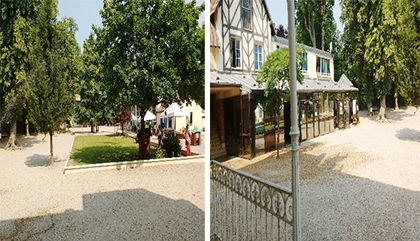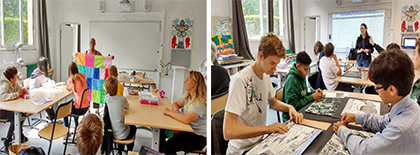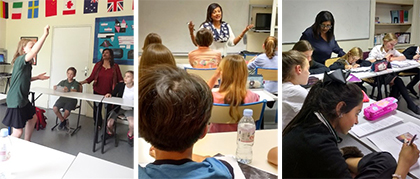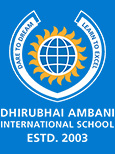Ermitage International School of France

A Report
On 29th May 2017, Pratima and I left for Paris to spend a month at the Ermitage International School of France. We had been selected to participate in the Teacher Exchange Program – the first of its kind in our school.
On arriving in Paris, we were escorted to the school which is located in Maisons Laffitte a beautiful town, 20km from Paris, surrounded by acres of forests. There are many historical buildings in the neighbourhood including the magnificent Chateau de Maisons which was built in the 17th century during the reign of King Louis XIV between the River Seine and the forest of Saint-Germain-en-Laye! We were warmly received by Mr. Ben Hunter, the Head of the IB Department who introduced us to other members of the faculty. Afterwards we had a lovely lunch at a restaurant overlooking the Hippodrome of Maisons-Laffitte which is a turf horse racing facility and track for Thoroughbred flat racing established in 1878.
Later we were taken to the apartment where we would be staying for the duration of our visit. Unfortunately, it was a disappointment. We expressed our concerns to Ben and Suzie Wondricl who promised to find us alternate accommodation in a couple of days. They kept their word and on the fourth day we shifted to a studio apartment which was not only comfortable but also conveniently located near the bus and train station.
On our first day at the school, we met the Chief Administrator, Janelle Dubois and her colleagues, Lily and Megan. We were assigned classes based on our subjects, Pratima for Maths and Science, and I, for History and English. However, the first lesson I observed was the one for French Intermediate students. It was an extremely interactive class of 8 students. It also helped me to brush up my rusty French!
We quickly settled into a routine. After breakfast at the apartment, we would walk to the bus depot to catch the bus to school. We used the bus cum train pass. (This proved to be our lifeline to Paris and we put it to good use!) In the days that followed we learned about the complexities of public transport. For instance, Bus No 12 dropped us at the school. But the next Bus No 12 didn’t stop at the school. The first time this happened, Pratima and I had to walk back. It was quite a long way and we arrived drenched in sweat!
Observations
For the first two weeks we observed lessons in our respective subjects in Grades- Foundation 1, 2 and 3 (3 being the eighth graders). Each class has a maximum of 12 to 15 students. The school implemented the Middle Years Program this year. Under this, the students have no fixed syllabus or text books. The curriculum is based on units/topics and its related concepts. Each unit is dealt with at length with great emphasis on ATL skills. Every effort is made to incorporate the skills into the learning process to ensure the children become strong, self-regulated learners.
One of the classes I attended was ‘Individuals in Societies’ which is similar to our History class. I learnt that, over a period of three months, the children were introduced to different civilizations simultaneously while focusing on one aspect at a time, e.g., culture, government, sustainability etc. In this period they were given ample opportunities for independent research. In the lesson I attended, the focus was on the use of astrolabes and quadrants. The teacher, Ms. Badruddin gave the children handouts with the image of a quadrant. Following instructions, the children constructed a simple quadrant which could be used to measure the height of objects. The next day the children were taken outdoors where they put their quadrants to use. They were encouraged to record and share their findings.
In another ‘Individuals in Societies’ class, conducted by Mr. Jeffrey Collie, the focus was global interaction, the key concept being the connection between the individual and the community. This involved a lot of class interaction and culminated with children making diagrammatic representations and flow charts of the ancient Roman republic and its salient features. The flow charts and diagrammatic representations clearly reflected their understanding and knowledge of the topic.
In an English lesson conducted by Danielle Cadd, the focus was writing detective stories. The children were instructed to make five columns: action, dialogue, description, mystery and foreshadowing. Then they were asked to write one-liners under each headings. They were encouraged to be creative. Emphasis was laid on ‘engaging’ first lines that would capture the attention of the reader. They shared their work with their respective partners and selected the best line. Subsequently, using the selected line, the children wrote the first paragraph of the story. Many children volunteered to read their work aloud to the class. This was encouraged by the teacher who took care to applaud their efforts and make useful suggestions as well.
One lesson which I found particularly interesting was IDU (Inter Disciplinary Unit). It spanned various disciplines. This particular unit involved writing poetry, visiting the Cluny Medieval Museum in Paris and learning the art of calligraphy and gold leaf printing. The children were free to write a poem on any topic of their choice and then use the medieval illumination skills and calligraphy learnt in Visual Arts to write out their poems on chart paper. The enthusiasm of the children was clearly reflected in their work and they had every reason to be proud of it. Their work was put on display so that their parents who were invited for Open Day could view it. The lesson called for close coordination and cooperation among the Art, English and History teachers. I should mention here that our Project day is an example of an Inter Disciplinary Unit on a much larger scale.
I also had the opportunity to observe a couple of Art lessons, one, where the children were making a quilt and another, where they had created beautiful mosaics on tiles. In both instances, the children had to design the item first and get it approved before beginning their work. From start to finish, the process takes a couple of weeks.

Mornings begin with a reading activity. Each child reads a book of their choice for one hour. I thought this a good practice as it inculcates a reading habit.

In the course of the next two weeks, we observed several lessons and also had the opportunity to conduct a few classes ourselves. I taught lessons in poetry, grammar, prose and history to Foundation 1, 2 and 3 respectively. The children were attentive, responsive and participated willingly in the class activities and discussions.
Visits
During the weekends, Pratima and I decided to explore Paris. Armed with the Bus/Train Pass, we visited several places of interest viz Musée de l'Orangerie, Tuileries Garden, The Louvre, The Eiffel Tower, and The Cathedral at Montmartre, to name a few. But not everything was smooth sailing …..On several occasions we got hopelessly lost and had to rely on the kindness of strangers to find our way back home! The intricate railway map with its Blue line, Yellow Line, Purple line, Pink Line was a great challenge but Pratima eventually managed to crack it. From then on, no place was inaccessible or too far for us!!
One weekend we decided to venture out further to the famous Loire Valley which is home to some of the grandest castles. Getting to Amboise, one of the towns in the valley was nerve-racking because our train was cancelled at the last minute and we had to catch a bus and then another train. But it was worth it. The Loire Valley is carpeted with fertile fields, crisscrossed by rivers, and studded with hundreds of châteaux of all shapes and sizes. There are several medieval castles because the Loire was a strategically important area during the Hundred Years’ War. We were able to visit the Chateaux of Chambord and Chenonceau. Wandering through the lavish interiors under vaulted ceilings, and the enormous towers in the corners, and viewing the pin-cushion roof of spires and chimneys and 100-foot tall lanterns was a unique experience.
We also visited the Château du Clos Lucé (or simply Clos Lucé), which was the official residence of Leonardo da Vinci. This was truly an unforgettable experience! In 1516, King Francis I of France invited Leonardo da Vinci to Amboise and offered him the Clos Lucé to stay in and work. Leonardo, arrived with three of his paintings, namely the Mona Lisa, Sainte Anne, and Saint Jean Baptiste. He lived at the Clos Lucé for three years and died there. The Château du Clos Lucé Museum displays forty models of machines designed by Leonardo. It also includes a copy of the Mona Lisa, painted by Leonardo. A stroll through the gardens makes one appreciate how nature was a source of inspiration for him.
We returned home the following evening.

Meetings and Assessments
During the last one and a half weeks, as it was the end of the academic year, teachers were busy completing portions and assessments. Each of their assessments has a rubric and the portion to be tested is not vast. In some instances, the students were allowed to use some of their research/reference material.
On Monday19th June, on reaching school we were informed that there was to be a series of staff and departmental meetings to evaluate and review the MYP which had been introduced that year. They were also going to formulate plans for the next year. They were keen to ensure that ATL skills were soundly incorporated in the plans. As we couldn’t really contribute very much in these meeting, the coordinators requested us to invigilate the Grade 11 exams so the respective teachers could be relieved. We were happy to oblige.
A few of the teachers were keen to know more about the activities and methods we follow at DAIS. At one of our lunches at the school canteen, the subject of food wastage came up. We told them how, over the years, the school reduced wastage. They have decided to take a leaf out of our book and start utilizing their waste to generate compost!
Differences
Overall, it was an interesting experience. We gained insights into the school’s teaching methods and pedagogical approaches as well as the opportunity to work with the students. However there are some major differences between the system they follow and the one we follow in DAIS.
- We do not follow the MYP.
- The strength of our classes is 32 not 12.
- We have a set syllabus with prescribed text books for each subject.
- We conduct a definite number of assessments.
- Our students do much more written work.
- We devote considerably more attention to the correction of the exercise books.
- Their assessments are accompanied by rubrics which are always shared with the children. We don’t do this.
In conclusion, while we may adopt some of their approaches and strategies in teaching, we cannot completely do away with books and a structured curriculum. Due to time constraints and number of children in the class certain activities will be difficult to conduct.
End Note
After three weeks, we were both a little homesick and anxious to return.
I will always have fond memories of our time here. During our stay in Paris, we encountered many people, from those who proudly claimed, “We do not speak English” to those who came to our rescue when we needed it the most. Be it the familiar face of the driver of Bus No 12 or the ever-smiling Head Chef at the school canteen who heaped large portions of mashed potato and overcooked broccoli on our plates, we had many special moments.
It was a privilege to work closely with the teachers and coordinators of the school, some of whom became our friends. They are a family of close-knit teachers with a common goal and their cooperation and willingness to share ideas and strategies in teaching was wonderful to see.
None of this would have been possible had I not been given this opportunity by Ms. Munshi. I would like to express my sincere thanks to her and also to Mr. Basu for his kind consideration and for stepping in to ensure we had a comfortable and stress-free stay in Paris.
Ann Iype
PS: I have attached a letter from Mr. Jeffrey H. Collie, Coordinator of Foundations 1 - 4 (Middle School), where he shares his thoughts about our visit.

